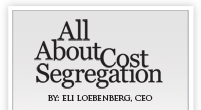Self-Storage Chain Uses Cost Segregation To Boost Cash Flow
Hearing of the benefits of cost segregation from his CPA, the owner of a chain
of Self-Storage Facilities turned to Madison SPECS, one of the nation's leading
cost segregation companies, to handle a comprehensive engineering and tax
assessment of one of his facilities in Fort Worth, Texas.
THE SITUATION:
Experiencing a slower economy and more competition coupled with the inability to
raise rents over the past few years, the owner of a chain of self-storage
facilities was feeling the pinch of stagnating cash flow. To test the value of
cost segregation, he hired Madison SPECS to perform a cost segregation study on
a 55,000 square foot facility he had constructed in 2005. The cost of the
facility excluding land was $2,500,000.
THE CHALLENGE:
For Madison SPECS, the project was typical of the cost segregation studies they
conduct on a daily basis. But for the self-storage facility owner, the biggest
challenge was just learning about the benefits of cost segregation in the first
place since he hadn't heard about it from other self-storage owners. This
wasn't surprising to the team at Madison SPECS. "Cost segregation is often
looked upon by self-storage owners as a competitive advantage that they do not
want to share... and for good reason," explained Moshe Becker, Director of
Operations for Madison SPECS. "The result of a cost-seg study on a typical
facility could double the after-tax cash flow for the current year depending
when the facility was originally placed in service,"" he explained.
Thanks to his CPA, the self-storage facility owner learned that his facilities
are a perfect fit for cost segregation since typically about 30 percent of the
cost can be classified to accelerated recovery periods. For instance, instead of
39 years, land improvements can be recovered in 15 years. This accelerated
depreciation helps owners defer federal and state income taxes.
THE PROCESS:
A typical 55,000-square-foot single-story self-storage facility, the depreciable
basis of the property was the hard and soft costs associated with the building,
site work and personal property. This was more than a matter of reclassifying
personal equipment to a five- or seven-year recovery period. Items reclassified
included land improvements, such as paving, curbing, site lighting, storm
drainage, fencing, and landscaping, as well as personal property including
signage, security systems, certain floor coverings and special climate-control
systems. The list was extensive.
Madison SPECS also worked to obtain the pricing on the interior removable panels
from the manufacturer of the prefabricated, self storage buildings. "Typically,
the manufacturer is able to provide their pricing, which is most accurate,"
explained Tom Varney, engineer for the project. Madison also depreciated the
removable interior partition panels and the HVAC systems for the climate
controlled units as 5-year property. Madison SPECS was able to deliver to the
client's CPA a very precise and comprehensive study in record time, just before
the end of tax season.
THE RESULTS:
While the Madison SPECS staff is accustomed to projects such as this, the client
was impressed by the results.
- The facility's total depreciable basis was $2,500,000 Of this total, the cost
segregation study permitted $575,000 to be reclassified from 39-year to 5-year
MACRS (Modified Accelerated Cost Recovery System) property.
- $245,000 was reclassified to 15-year MACRS property.
- This reclassification of assets resulted in a Net Tax Benefit of $50,000 in the
first year and a $245,000 Net Tax Benefit over the firs six years.
The self-storage facility owner was so pleased with the results that he hired
Madison SPECS to prepare cost segregation studies for his other seven
self-storage facilities.








